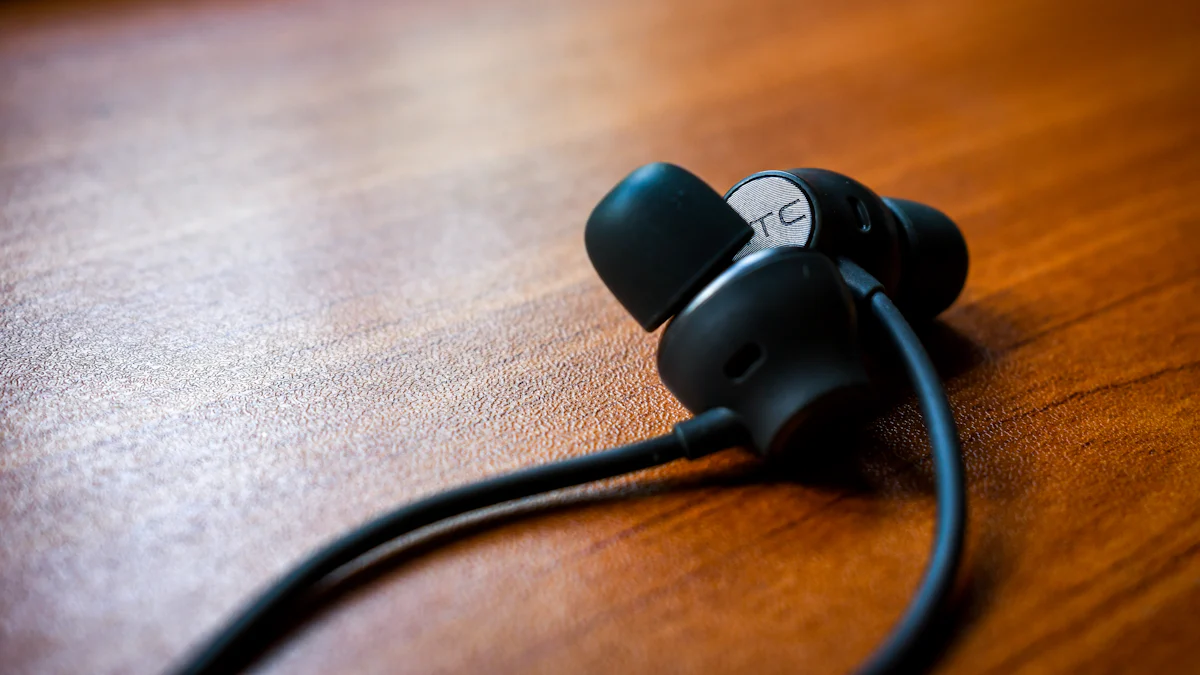Sound Professional on Zoom: Easy Equipment Tips

Ever wondered how to sound professional on Zoom calls? It's easier than you think! With the right equipment, you can transform your audio quality from average to outstanding. Imagine having crisp audio that makes every word you say clear and engaging. People often praise Zoom for its call quality, which is forgiving even with bandwidth issues. By choosing the right tools, like a good microphone or headset, you can ensure your voice comes through loud and clear, even in busy environments. Let's dive into some simple tips to help you achieve that professional sound.
Key Takeaways
- Invest in a quality microphone to enhance clarity and reduce background noise during Zoom calls.
- Choose the right headphones to isolate your voice and provide clear audio feedback, minimizing echo.
- Consider using an audio interface for superior sound quality and greater control over your audio settings.
- Position your microphone close to your mouth and adjust input levels to avoid distortion and ensure crisp sound.
- Manage your environment by reducing background noise and improving room acoustics for better audio clarity.
- Utilize software tools like noise suppression and equalizer settings to further enhance your audio quality.
- Experiment with different equipment and settings to find the best combination that works for your unique voice and environment.
Choosing the Right Microphone

When it comes to Zoom calls, your microphone plays a crucial role in how others perceive your professionalism. A good microphone ensures that your voice is clear and free from distortion, making your communication more effective.
Why a Good Microphone Matters
You might wonder why investing in a quality microphone is important. Well, a good microphone captures your voice accurately, reducing background noise and enhancing clarity. This means you can focus on your conversation without worrying about whether others can hear you clearly. It’s a simple step that can make a big difference in how to sound professional on Zoom calls.
Recommended Microphones for Zoom
Choosing the right microphone can seem daunting, but it doesn't have to be. Here are some great options to consider:
USB Microphones
USB microphones are popular for their ease of use and excellent sound quality. They plug directly into your computer, making setup a breeze. The Blue Snowball Ice is a fantastic choice. It offers good audio quality at an affordable price and comes with a tripod for easy positioning. Another option is the Tula USB-C Microphone, which not only looks stylish but also provides excellent noise reduction and sound quality.
Lavalier Microphones
If you prefer something more discreet, lavalier microphones are a great option. These clip-on mics are perfect for hands-free use and are ideal for presentations or interviews. They capture sound directly from your voice, minimizing ambient noise.
Microphone Setup Tips
Once you've chosen your microphone, setting it up correctly is key to achieving the best sound quality.
Positioning Your Microphone
Positioning your microphone correctly can significantly impact your audio quality. Place the microphone close to your mouth, but not too close to avoid distortion. For USB microphones like the Blue Snowball Ice, use the included tripod to position it at a comfortable height. Ensure it's angled towards your mouth for optimal sound capture.
Adjusting Microphone Settings
After positioning your microphone, adjust the settings to suit your environment. Most microphones allow you to tweak input levels. Set the input level so your voice is clear without peaking. This prevents distortion and ensures your voice remains crisp. Experiment with different settings to find what works best for you.
By choosing the right microphone and setting it up properly, you can greatly improve how to sound professional on Zoom calls. These simple steps will help you communicate more effectively and leave a lasting impression.
The Role of Headphones

Headphones play a vital role in ensuring you sound professional on Zoom calls. They help isolate your voice from background noise and provide clear audio feedback, making your communication more effective.
Benefits of Using Headphones
Using headphones during Zoom calls offers several advantages:
- Noise Isolation: Headphones block out ambient noise, allowing you to focus on the conversation.
- Clear Audio Feedback: They provide direct audio feedback, helping you hear others clearly.
- Reduced Echo: Headphones prevent audio from your speakers from being picked up by your microphone, reducing echo and feedback.
Recommended Headphones for Clear Audio
Choosing the right headphones can significantly enhance your Zoom call experience. Here are some top recommendations:
Over-Ear Headphones
Over-ear headphones offer excellent sound quality and comfort. They cover your ears completely, providing superior noise isolation. The Bang & Olufsen Beocom Portal is an ideal choice for most work-from-home needs. It has been tested by Zoom and marked suitable for the platform, ensuring you get the best audio experience.
In-Ear Monitors
In-ear monitors are compact and portable, making them perfect for on-the-go use. They fit snugly in your ears, offering good noise isolation and clear sound. Consider options like the Shure SE215 for their balance of quality and affordability.
Headphone Setup Tips
Proper setup of your headphones can make a big difference in comfort and audio quality.
Ensuring Comfort and Fit
Comfort is key when wearing headphones for extended periods. Adjust the headband and ear cups to fit your head snugly but not too tight. For in-ear monitors, try different ear tips to find the best fit. A comfortable fit ensures you can focus on your call without distractions.
Managing Audio Levels
Managing audio levels is crucial for clear communication. Set your headphone volume to a comfortable level where you can hear others clearly without straining. Avoid setting the volume too high to prevent hearing damage. Regularly check your audio settings to ensure optimal performance.
By selecting the right headphones and setting them up correctly, you can greatly improve how to sound professional on Zoom calls. These simple steps will enhance your audio experience and help you communicate more effectively.
Enhancing Audio with Interfaces
Ever thought about taking your Zoom audio to the next level? An audio interface might be just what you need. These handy devices can transform your sound quality, making you sound like a pro. Let's explore how they work and which ones might suit your needs.
What is an Audio Interface?
An audio interface acts as a bridge between your microphone and computer. It converts analog signals from your mic into digital signals that your computer can understand. This conversion ensures high-quality audio transmission, which is crucial for clear communication. With an audio interface, you can enjoy better sound fidelity and more control over your audio settings.
Recommended Audio Interfaces for Zoom
Choosing the right audio interface can make a big difference in how to sound professional on Zoom calls. Here are some options to consider:
Entry-Level Interfaces
If you're new to audio interfaces, start with something simple. The Focusrite Scarlett Solo is a popular choice. It's user-friendly and offers excellent sound quality at an affordable price. Another great option is the Behringer UMC22, which provides solid performance without breaking the bank.
Professional Interfaces
For those seeking top-notch audio quality, consider professional-grade interfaces. The Zoom AMS-24 Audio Interface is designed for musicians and streamers. It offers seamless integration with digital audio workstations (DAWs) and platforms like YouTube and Twitch. This interface ensures your audio remains crisp and clear, even during complex setups.
Setting Up Your Audio Interface
Once you've chosen your interface, setting it up correctly is essential for optimal performance.
Connecting to Your Computer
Start by connecting your audio interface to your computer using a USB cable. Most interfaces come with plug-and-play functionality, so your computer should recognize it automatically. If not, you may need to install drivers from the manufacturer's website.
Configuring Audio Settings
After connecting your interface, adjust the audio settings on your computer. Open your sound settings and select the audio interface as your input and output device. This ensures that all audio passes through the interface, providing superior sound quality. Test your setup by speaking into your microphone and listening through your headphones. Make any necessary adjustments to achieve the best sound.
By incorporating an audio interface into your setup, you can significantly enhance your Zoom call experience. These devices offer greater control over your audio, helping you sound professional and polished. Give it a try and see the difference it makes!
Additional Tips for Better Audio
Managing Your Environment
Creating a conducive environment can significantly improve your audio quality during Zoom calls. Here are some practical tips to help you manage your surroundings effectively.
Reducing Background Noise
Background noise can be a major distraction during calls. To minimize it, try these strategies:
- Close Windows and Doors: This simple step can block out external sounds like traffic or construction noise.
- Use Soft Furnishings: Items like curtains, carpets, and cushions can absorb sound, reducing echo and background noise.
- Position Yourself Wisely: Choose a quiet room away from noisy appliances or busy areas in your home.
Active Noise Cancellation (ANC) technology can also help. It uses microphones to detect external sounds and generates inverse sound waves to cancel them out. This technology is especially useful if you can't control the noise in your environment.
Improving Room Acoustics
Good room acoustics can enhance your audio clarity. Here are some ways to improve them:
- Add Soft Surfaces: Soft surfaces like rugs and upholstered furniture can absorb sound, reducing echo.
- Use Acoustic Panels: These panels can be mounted on walls to absorb sound and improve acoustics.
- Rearrange Furniture: Position furniture to break up sound waves and reduce echo.
By managing your environment, you can create a space that supports clear and professional audio.
Software Tools for Audio Enhancement
Software tools can further enhance your audio quality, making your Zoom calls sound even more professional.
Noise Suppression Software
Noise suppression software can filter out unwanted sounds, ensuring your voice remains clear. Zoom offers built-in noise suppression settings that you can adjust to suit your needs. You can also explore third-party software options for more advanced features.
Equalizer Settings
Adjusting equalizer settings can help you fine-tune your audio. An equalizer allows you to adjust different frequency bands, enhancing the clarity and richness of your voice. Experiment with different settings to find what works best for your voice and environment.
By utilizing these software tools, you can take your audio quality to the next level. These enhancements will help you sound professional and polished on every Zoom call.
You've now got the tools to sound professional on Zoom calls. Using the right equipment can transform your audio quality, making your voice clear and engaging. Try these tips on your next call:
- Invest in Quality Gear: A good microphone and headphones make a big difference.
- Set Up Properly: Position your equipment for optimal sound.
- Enhance with Software: Use noise suppression and equalizer settings.
Give these strategies a shot. You'll notice an improvement in your audio quality, making every conversation more effective and enjoyable.
FAQ
What equipment do I need to sound professional on Zoom?
To sound professional on Zoom, invest in a quality microphone and headphones. A USB microphone like the Blue Snowball Ice or a lavalier microphone can enhance your voice clarity. Over-ear headphones such as the Bang & Olufsen Beocom Portal provide excellent noise isolation.
How do I set up my microphone for the best sound quality?
Position your microphone close to your mouth but not too close to avoid distortion. Use a tripod for USB microphones to keep it stable. Adjust the input levels in your settings so your voice is clear without peaking.
Why should I use headphones during Zoom calls?
Headphones help isolate your voice from background noise and provide clear audio feedback. They prevent echo by stopping audio from your speakers from being picked up by your microphone.
Can an audio interface improve my Zoom call audio?
Yes, an audio interface can significantly enhance your sound quality. It acts as a bridge between your microphone and computer, ensuring high-quality audio transmission. Consider entry-level interfaces like the Focusrite Scarlett Solo for a start.
How can I reduce background noise during my calls?
Close windows and doors to block external sounds. Use soft furnishings like curtains and carpets to absorb sound. Position yourself in a quiet room away from noisy appliances.
What are some recommended software tools for audio enhancement?
Zoom offers built-in noise suppression settings. You can also explore third-party noise suppression software for advanced features. Adjusting equalizer settings can help fine-tune your audio for better clarity.
Do I need to use an audio interface if I already have a good microphone?
While a good microphone can improve your audio, an audio interface provides additional control over your sound settings. It ensures better sound fidelity, especially if you want to achieve a more professional audio setup.
How do I ensure my headphones fit comfortably?
Adjust the headband and ear cups for a snug fit. For in-ear monitors, try different ear tips to find the best fit. Comfort is key for long calls, so make sure your headphones don't cause discomfort.
Are there any specific brands of microphones or headphones you recommend?
For microphones, consider the Blue Snowball Ice or Tula USB-C Microphone. For headphones, the Bang & Olufsen Beocom Portal and Shure SE215 are excellent choices for their sound quality and comfort.
Do you still have questions about digital recorders and how to find the best Zoom recorder for your content?
Keep reading to learn more about Zoom recorders and get answers to some of the most commonly asked questions about digital recorders.
See Also
Tips for Effectively Managing Your Hybrid Zoom Meetings
A Comprehensive Guide to Enhancing Computer Audio Visual Skills
Key Strategies for Running Effective Video Conferences
Essential Steps for Perfecting 360 Degree Product Photography
